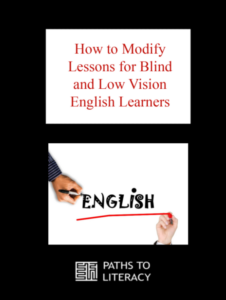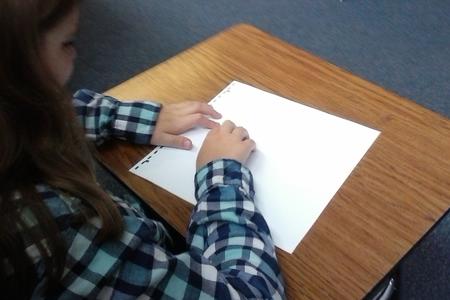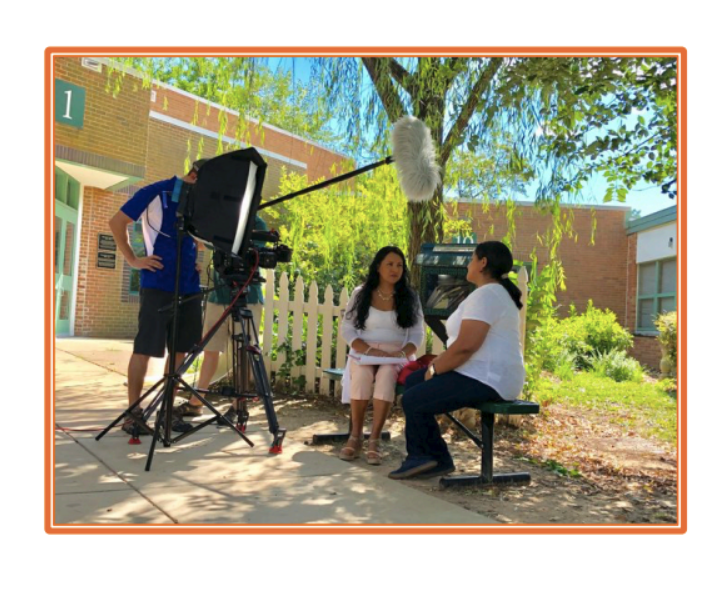Blind and low-vision English learners have a unique set of needs that many educators do not feel ready to meet. This process guide is meant as a starting point for educators so that they can gather information to make the best decisions for their students, keeping in mind the visual as well as language needs that this group of students needs in order to be successful in our public schools.
When working with blind or low-vision English learners, keep in mind that each student is different and has different needs. Being familiar with particular students will help you find the appropriate ways to support them. Likewise, language skills develop at various times and with various speeds, and students benefit from good instruction overall. Including your blind and low-vision English learner in your lessons is best practice for supporting students’ language development and needs due to their disability.
This template serves as a starting point for modifying instructional materials for blind and low-vision English learners. Steps 1 and 2 can be completed once for each student. Steps 3 to 5 should be done per lesson.
Student:
STEP ONE: Gather information on the student’s vision needs.
| How does the student access reading (check all that apply)? |
| ☐ Braille☐ Large print☐ Audio☐ Computer with screen reader ☐ Magnification device: ☐ Read aloud☐ None yet determined at this time☐ Other: |
| How does the student access writing (check all that apply)? |
| ☐ Braille device☐ Computer with QWERTY Keyboard☐ QWERTY keyboard with large/high-contrast letters☐ Computer with screen reader☐ Regular writing with paper and pencil☐ Bold lined paper and bold pen☐ Magnification device: ☐ Scribe☐ None yet determined at this time☐ Other: |
Technology the student uses to access education:
Does the student have any other disabilities that need to be taken into account? If so, how?
| Is there anything else in the IEP listed under Accommodations/Modifications that the student should have access to during lessons? |
| ☐ Extended Time ☐ Read aloud☐ Pre-Teaching ☐ Other: |
Student/family input on what works well for their learning:
STEP TWO: Gather information on student EL needs.
What level did the student test in Access WIDA (the ESOL teacher will have this information in a report)?
| Score | What does this score mean for this student? |
| Listening: | |
| Speaking: | |
| Reading: | |
| Writing: |
What is the student’s home language?
STEP THREE: What is the activity/lesson you are doing? How is it going to be modified to fit all needs?
Lesson task:
Purpose of the lesson/assignment:
Standard aligned to grade level (if relevant):
What are the language objectives?
| Skill needed for the lesson | How will it be modified for the student’s English level? | Is there a modification that needs to take place due to vision? | |
| Listening | |||
| Speaking | |||
| Reading | |||
| Writing |
Materials in the lesson:
☐ Are there images the student needs access to?
☐ Are there any orientation and mobility issues that need to be taken into consideration?
| Material | How it will be modified to fit vision needs | Who is in charge of making or ordering the modification? |
If the TVI is going to modify content, please give it to them at least a week in advance.
STEP FOUR: Build background knowledge.
Cultural background knowledge needed for the lesson (cultural content, experiences, etc.):
Who will pre-teach:
Aspects of the lesson that are visual in nature and require background knowledge:
Who will pre-teach:
Vocabulary that is critical to the lesson:
Who will pre-teach:
STEP FIVE: Try the strategy.
| Worked well | Needs additional support | Comments | |
| Use of their technology to access content | ☐ | ☐ | |
| Materials worked for the student (accessible, readable, etc.) | ☐ | ☐ | |
| Student was engaged based on their English level | ☐ | ☐ | |
| Background knowledge was relevant to lesson | ☐ | ☐ |
Resources
Strategies and Information for English Learners
- Colorín Colorado: How to Develop a Lesson Plan that Includes ELLs
- The Role of Background Knowledge
- 10 Strategies for Building Relationships with ELLs
- Colorín Colorado: ELL Strategies & Best Practices
- Evidence-Based Practices for English Learners by the CEEDAR Center
- Dr. Mora-Flores Resources (under ELD strategies)
Strategies for Blind/Low-Vision English Learners
- Using Alexa devices with your blind and low-vision multilingual students
- American Printing House for the Blind products: Can be purchased with APH Quota funds
- Understanding ACCESS Scores and Reports
Accessibility
- Learn how to make your virtual documents accessible.
- Images: Images can be made available to the student with tactile images, or alt text can be added into an electronic document (Word, Google Docs, etc.).
- BRF files (if the student has an electronic braille display, this file can be emailed to the student to read on their device, or sent to the TVI to emboss (print) into braille)
- Give you suggestions on APH Quota eligible materials for this lesson





